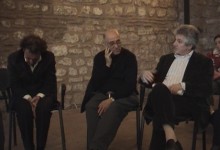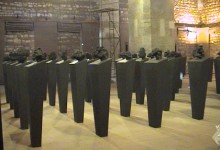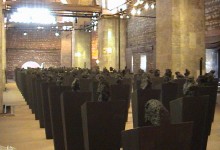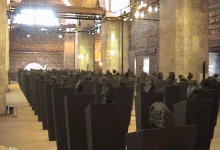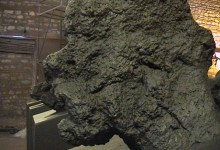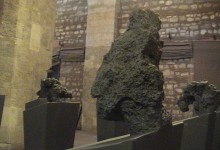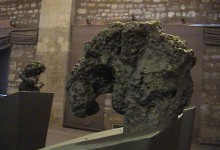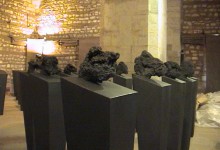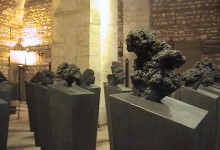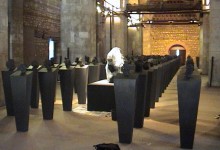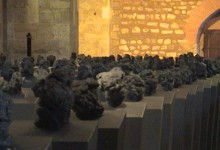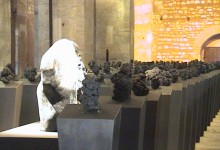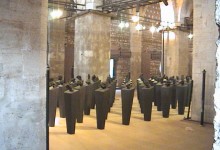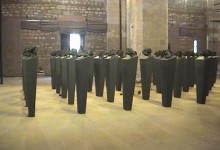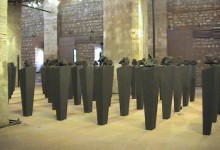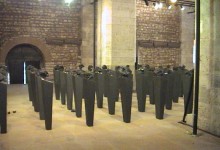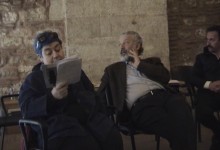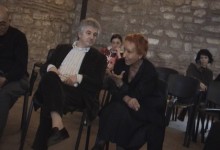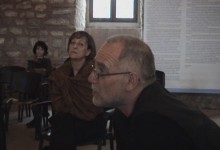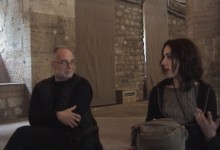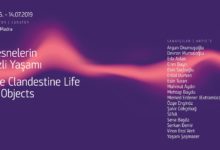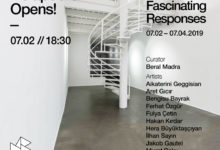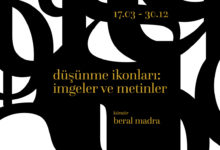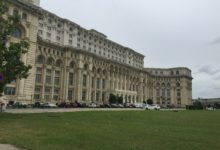“SORGENTE/ SOURCES”
BIZHAN BASSIRI
TOPHANE-İ AMİRE,ISTANBUL
10 -29 APRİL 2004
Curators: BERAL MADRA / BRUNO CORA
A Collaboration of ISTITUTO ITALIANA CULTURALE, MIMAR SINAN UNIVERSITY, BM CONTEMPORARY ARTCENTER
Sponsor:UNICREDITO
Coordination and PR: NİLÜFER SÜLÜNER
Press Conference:8 APRIL 2004, THURSDAY, 11 AM
Opening:9 APRIL 2004, FRIDAY,7 PM
Roundtable:10 APRIL 2004, SATURDAY,4-6 PM, MSÜ ODITORIUM
THE CONTENT OF THE EXHIBITION
BEAST / CANAVAR, BASALT SCULPTURE, 120 HERMS, 60 READING DESK, BOOKS, 12 SUN MIRRORS
MUSİC : GIORGIO BATTISTELLI/STEFANO TAGLIETTI
PERFORMANCE 20’: “EVENT OF MAGMATIC THINKING”
60 ELEMENTS OFCOROAND 60 STICKS (WITH MSÜ STUDENTS)
Curriculum Vitae of Bishan Bassiri
Bizhan Bassiri was born inIran(Teheran) in 1954. He arrived toItalyin 1975 and lives since then inRomeand in San Casciano del Bagni (Sicily). He is producing sculpture, poetry, performance, video and music and combining these medias in large scale installations.
Since 1984 he has realized his solo exhibitions in Galleria Lucrezia Dimizio Durini, Pescara; Palazzo Taverna, Rome; American Academy, Rome; Gelleria Pieroni, Rome; Palazzo Diocleziano, Spilit; Studio Stefania Miscetti, Rome; Centre d’Art Contemporain, Thiers (France); Spazio Umano, Milan; Galleria Guidio Marisei, Vienna; Borholms Kunstmuseum, Borholms (Denmark); Ecole des Beaux-Arts, Dunkerque (France); Museum Labarotory of Modern Art, La Sapienze University of Rome, Rome; ArsAevi, Sarajevo. Since 1981 he participated in numerous group shows, among these Avanguardie-Transavanguardie, Achille Bonito Oliva, Mura Aureliane, Rome (1982); IX. Sydney Biennial Exhibition, Australia (1992); Punti Cardinali, XLV Venice Biennial (1993); Jetztzeit, Saskia Boss, Kunsthalle, Vienna (1994); Corpus Delicti, Jan Hoet, Museum ven Hedehdaagse Kunst, Ghent (Belgium) (1995); Forma Urbis, Bruno Cora, XXIII Biennale Gubbio, Gubbio (1996); The Collection in the New Museum of Contemporary Art, Jan Hoet, SMAK, Ghent (Belgium) (1999); Ventana Hacia Venus, Teatro Nacional, Bienal de la Habana, Havana (2000).
Since 1990 he performed in various concerts with musicians Giorgio Battistelli, Stefano Taglietti, Alessandro Cipriani, Hans Werner Henze.
THE CONCEPT OF THE EXHIBITION
Bassiri’s exhibition in Istanbul entitled “Sources” stands for his desire to make a commencement towards the East; it is an attempt to change the course of action, he made 50 years ago from East to the West. He fulfills this task with an intricate modus operandi, exploiting different layers of schemes, ideas and concepts and bringing into play the tools of global economic system.
The basis of his work is his spiritual association and obsession with the volcanic scenery which he discovered in the Vesuvius volcano. For him the power and energy concealed in the magma of the volcano is a metaphor for the creation and the source of life as well as for art which is for him “a meteorite from outer space that only appears on earth, but is not of the earth.” Out of this magmatic entity he produces a particularity consisting of individual heads (portraits) resting on iron herme which implies an act of distribution of power and energy.
The word herme which is Etruscan is quite significant for the Greek god Hermes, the herald of the Olympian gods, son of Zeus and the Nymph Maia. Hermes stands for shepherds, land travel, merchants, weights and measures, oratory, literature, athletics and thieves. He is a cunning and shrewd god. As he is the messenger of the gods, Hermes is usually depicted with a broad-brimmed hat or a winged cap, winged sandals. However, his name is related to herma which is in fact a square or rectangular pillar or shaft in either stone or bronze, with the head of Hermes. It was used as road and boundary marker. Bassiri borrowed this form for his sculptures and for his manifest. As the messenger of multiple and ambiguous identities, such as a guide, a nomad, a speculator of form and content, a bearer of knowledge and wisdom, the artist himself is allegorically represented in this legion of herms.
Bassiri’s fascination with Hermes has its roots in the philosophical speculations about this god, considered as one of the most controversial mythological figures.
From a contemporary view, the figure of Hermes stands as an archetype of transformation through reconciliation of the opposites, because he crosses from one zone to the other, he is visible and invisible, he mediates between waking and dreaming. Jung and other archetypal oriented psychoanalysts viewed Hermes in this light. In this sense, Bassiri makes use of this god as representing the contemporary artist, crossing the borders and mediating between two poles, i.e. the darkness, ignorance, perplexity and enlightenment, information, wisdom.
A scholar indicates that Hermes is a mediator/messenger between Zeus and mortals; he crosses these ontological thresholds with ease. He is neither here, nor there; therefore liminality or marginality is his very essence. (1) Here, liminality (threshold) and marginality (on the edge) are two key words for today’s unpredictable and incompatible situations of the post-modern world and for the individual easily adopting all positions available.
Another scholar argues, “It is from the standpoint of this marginal zone that the great artists, writers, and social critics have been able to look past the social forms in order to see society from the outside and to bring in a message from beyond it.”(2)
These arguments also explain Bassiri’s approach to the theme. His approach may be philosophical and cryptic; however, it is clear that he focuses on the benefits of unity of individual energy and on the function of the artist as a messenger.
On the other hand, in Bassiri’s choice of herm, we can also trace the word hermeneutics “which is the discipline concerned with deciphering utterances from other times, places, and languages–without imposing one’s own categories on them.”(3) In this on-line article, Palmer also relates this idea to Heidegger’s line of reasoning that human beings, insofar as they are truly human beings, are hearing the message. They are listening and belonging to it as human beings. For Heidegger this special and intense listening is necessary in order to break away from the confines of the modern worldview (4). When applied to the concept of the installation of Bassiri, this may sound traditionalist. However, we should consider that people, are not listening intensely anymore, because they are visually distracted by the digital image excess. We should take into account that the unpredictable and confusing limits and openings of post-modern living and global complexity may be unconquerable.
Here, we should think about that Bassiri has conceived and produced this work for Sarajevo, which during 90’s was the traumatic arena, in the bloody conflict zone between Christianity and Islam at the East edge of Europe. The basalt beast, representing the evil was juxtaposition to the serenity of herms with volcanic stone portraits. Obviously, Bassiri’s intention was to lay a foundation of neutrality in the form of ancient philosophy and mythology, in order to gain the ground for a world-shaking critique on the prevailing absence of memory, lack of knowledge and brutality in and out ofEurope. The beast stays inSarajevo in the contemporary art museum ARSAEVI as the memory of the wickedness. Now, at the time he transports the work toIstanbul, the zone of conflict and evil has already shifted to the East.
Bassiri employs this archetypal presentation with its concepts of wisdom, sensitivity and insight as well as with its implications to the malice to take in our collective unconscious. He let us reflect on questions like where I am coming from, where am I going to and, what is my role in this drama.
Beral Madra/ February 2004
1. Richard E. Palmer, www.mac.edu/faculty/richardpalmer/The Liminality of Hermes and the Meaning of Hermeneutics.
2. ibid
3. ibid
*************************************************************************
CATALOGUE TEXT:
SORGENTE/SOURCES
The exhibit at Tophane-i Amire, on April 2004 stunned the art community of Istanbul, as it was one of the most inspiring works that was ever been shown in this historical setting. Bizhan Bassiri, the Italian artist of Iranian origin has successfully installed his work into this basilica shaped space, skilfully enhancing and preserving its essence. Artists, in their lifetime may have moments of perfection in exhibiting their works; for Bassiri this installation in Tophane-i Amire had such a significance.
From the perspective of architecture, a basilica is a hierarchic and magnificent hall; even though it is a Roman and Byzantine structure, its origin is in the East. In general it is an open and well lit space used for ceremonies and meetings, and as Vitrivius described it, it is a rectangle of which the length is twice as long as its width, and columns or pillars separate the middle from the sides. Tophane-i Amire has all the features of this Byzantine plan even though it is an Ottoman building.
The building is an exquisite example of the tolerance of the Ottoman culture towards inherited cultures. It is erected during the reign of Mehmet the Conqueror as an arsenal and restored during the reigns of Beyazıt the Second, Suleiman the Magnificent and Selim the Third. The building even served as an arsenale throug the second half of twentieth century. In 2000 it was granted to Mimar Sinan Fine Arts University to be used for artistic and cultural events. Although it was built for secular reasons – in this case, for war – the inner space has a sacred – when not religious – atmosphere.
Bassiri’s portraits of slightly modulated magma stones collected from Vesuvius volcano set on hundred twenty iron herme were installed along the middle hall in four rows. In the middle front, but in reverse direction to the procession, a bronze beast stood with its dangerously imposing mass, ready to attack. Behind this procession of herme-portraits, another column of herme, arranged vertically, carried the 60 hand written books of Bassiri. These books contain his poems in Italian and Persian, however not as a translation from one language to the other, but as verses of the same meaning. He has written the poems since 1983 as a kind of diary. For the opening of the exhibition, the students of the Mimar Sinan Fine Arts University performed an improvised ceremony with the music of Giorgio Batistelli in combination with the manifesto of Bassiri. Scepters adorned with points of red turbans, specially produced for this Ottoman space were used to create an additional sound to the music, exploiting the physical aspects of the architecture, sweeping and echoing through the sculptures.
Even though the work convincingly looks as if it was specifically created for this space, this ensemble of work was produced in 2002 for Sarajevo in reference to the memory of war and the East-West characteristic of the city . For Bassiri,Sarajevobecame a particular bearing with two connotations: He wanted to re-establish the relationship to his home country, which he had left in his early twenties during the turmoil of the approaching war and disaster. Moreover, he wanted to walk towards East after so many years. After accomplishing his mission, he left “the Beast” inSarajevoas a gift to Ars Aevi, the contemporaryart museumofSarajevo, which was founded as a thorch of enlightenment against the darkness of the war.
InSarajevo, this ensemble of work uniting the characteristics of art and culture of East and West was registered as a “message” to the nations involved in this war and peace. Consequently, he transported this “message” toIstanbul.
The arrangement of the work in Tophane-i Amire reflects a multi-faceted scheme of movement: As an army of people heads towards the entrance of the space, a beast, although encircled by this group of people, moves dangerously close to them. The beast conveys a paradox of positive and negative energy; a positive energy intrinsic in human beings, which in an instance of insanity can turn into a negative one. The book section, as a symbol of wisdom and creative thinking, limits and somehow restricts the antagonism that is being developed in the middle. The intersection of these two movements and the physical data of the space formes a harmonious crucifix, again pointing to the original function of the space. However, in spite of this harmony, the inner movement of the work reminds us the animosity or war.
Evidently, the war and its peculiar appearance in the process of globalisation became the reason of this work of Bassiri. One of the bloodiest wars of humankind has happened on the eastern border ofEurope. The struggle inSarajevoreminded Bassiri the tragic memories of war of his youth. In the age of impertinent digital war scenes, he had no intention to show the war in an unequivocal way. For him it was more significant to traverse into the reasons of war and prove the fundamental dilemma. The scheme of the installation insinuates that the war will be inevitable if the harmonious order structured by the procession of wise humanity (volcanic stone, herme and books) is defeated by the negative energy of the evil (the beast).
Within this work of different techniques and ways of expression from East and West, one can realize the power of the drive for battle and the other instincts that can cultivate this drive, because this ensemble of work with the books encapsulates a humanistic approach. To perceive this, Bassiri invited the viewer to a certain sensibility and instinct towards these objects.
The portraits of modulated Vesuvius stones change from side to side; they alienate, terrify or caricaturise. They depict heterogenic human typology yet they also confirm a community with inner harmony. In some way, because of the disciplined individuality of the volcanic stones, in relation to the Ottoman background of the building, they materialize as a kind of religious community.
The particular portrait styles recall the neo-expressionistic tendencies of the 1980’s; all aspects of this movement, the simultaneity, the abstraction and the surrealism are clearly visible. However, the herme is a heritage of antique civilisation and is very modernist in its minimalist form. As a result, an irritating tension as well as a surprising harmony has been created between the traditional art, modernism and post-modernism. The beast in the middle of this human community also looks extremely archaic; it is beautiful and ugly at the same time; its heavy mass is starting to jump and sublimate the evil. In comparison to these solid and long-lasting materials, the books at the back rows are ephemeral and vulnerable. One cannot fail to notice that the corpus of human presentation (herme), the positive and negative spirit (the books and the beast) and the energy (the scheme of the installation) form a classical triangle of harmony.
We have to pay attention to the sculpture itself as well as to its art historical memory when we are talking about the ensemble of sculptures that encompasses all these traditional, modernist and post-modernist canon, particularly in the age of digital images dealing with the trivialities of the daily life. Here, a radical shift of gaze is essential. This installation gives us the opportunity to view the legitimacy of the sculpture in two ways. The one is the scrupulous objectivity of the sculpture within all the objects and the other is the power of the sculpture to
re-define the space – in this case in collaboration with other ways of expression such as music and poetry.
Huge installations of this kind –accumulated figures and materials exploiting and at the same time paying tribute to the given space – have been realized in spaces of different cultural and physical aspects during the 80’s and 90’s. The roots are in Arte Povera and Minimalism. Accordingly, historical buildings inIstanbulhave inspired many artists, though not always successfully! However, installations of artists like Daniel Buren, Richard Long, Sol le Witt (1989, in an annex of the mosque of Suleiman the Magnificent), Raffael Rheinsberg (1992, in Yıldız Palace Arsenale) had one common quality: The viewer always had the impression that the work is elevating the space to a super-transcendence or to an re-enchantment. We can integrate Bassiri’s work into this category.
Bassiri’s fascination with Hermes has its roots in the philosophical speculations about this god, considered as one of the most controversial mythological figures. The word herme, which is Etruscan, is quite significant for the Greek god Hermes, the herald of the Olympian gods, son of Zeus and the Nymph Maia. Hermes stands for shepherds, land travel, merchants, weights and measures, oratory, literature, athletics and thieves. He is a cunning and shrewd god. As he is the messenger of the gods, Hermes is depicted with a broad-brimmed hat or a winged cap, winged sandals. However, his name is related to herm, which is in fact a square or rectangular pillar or shaft in either stone or bronze, with the head of Hermes. It was used as road and boundary marker. Bassiri wisely borrowed this form for his sculptures and for his manifest. As the messenger of multiple and ambiguous identities, such as a guide, a nomad, a speculator of form and content, a bearer of knowledge and wisdom, the artist himself is allegorically represented in this legion of herms.
From a contemporary view, the figure of Hermes stands as an archetype of transformation through reconciliation of the opposites, because he crosses from one zone to the other, he is visible and invisible, he mediates between waking and dreaming. Jung and other archetypal oriented psychoanalysts viewed Hermes in this light. In this sense, Bassiri makes use of this god as representing the contemporary artist, crossing the borders and mediating between two poles, i.e. the darkness, ignorance, perplexity and enlightenment, information, wisdom.
A scholar indicates that Hermes is a mediator/messenger between Zeus and mortals; he crosses these ontological thresholds with ease. He is neither here, nor there; therefore liminality or marginality is his very essence. (1) Here, liminality (threshold) and marginality (on the edge) are two key words for today’s unpredictable and incompatible situations of the post-modern world. For the individual to be able to easily adopt all available positions is the cutting edge in the contemporary political, economic and cultural decisions.
Another scholar argues, “It is from the standpoint of this marginal zone that the great artists, writers, and social critics have been able to look past the social forms in order to see society from the outside and to bring in a message from beyond it.”(2) This is precisely the position of Bizhan Bassiri.
On the other hand, in Bassiri’s choice of herm, we can also trace the word hermeneutics “which is the discipline concerned with deciphering utterances from other times, places, and languages–without imposing one’s own categories on them.”(3)
A crucial philosophy, intrinsic in the concept of this installation, which should be adopted to avoid the clashes between civilisations.
When people are not able to listen and reflect intensely anymore, because the digital image excess visually distracts them, we should take into account that the unpredictable and confusing limits and openings of post-modern living and global complexity may be unconquerable.
These arguments may also explain Bassiri’s approach to the theme. His approach may be philosophical and cryptic; however, it is clear that he focuses on the benefits of unity of individual energy and on the function of the artist as a messenger. The position of the artist today may be in discussion; the conviction may be that the artist has lost his/her privileged place and function and that he/she is being sucked into the abysses of the mass and commodity culture. There may be a certain ground of negotiation in the life of today’s artist. Yet, how it is concluded can only be viewed in the work itself. One can say that only the works that reflect the truth from the standpoint of this marginal zone can go beyond this fatale impasse, as described in Bassiri’s installation.
Bassiri employs this archetypal presentation with its concepts of wisdom, sensitivity and insight as well as with its implications of malice in our collective unconscious. He lets us reflect on questions like “Where I am coming from?”, “Where am I going?” and “What is my role in this drama?”. His approach may be philosophical and cryptic, but the viewer can deduce many conclusions.
Bassiri has conceived and produced this work for Sarajevo, which during 90’s was a traumatic arena, located in the bloody conflict zone between Christianity and Islam at the East edge of Europe; yet when he transported the work to Istanbul the zone of conflict and evil had already shifted to the East. What a good timing! Obviously, Bassiri’s intention was to lay a foundation of neutrality in the form of ancient philosophy and mythology, in order to gain the ground for a world-shaking critique on the prevailing absence of memory, lack of knowledge and brutality in and out ofEurope.
Once more, Bassiri’s timely attempt to reverse the journey he had made 20 years ago and return to the East throughIstanbulis firmly related to the state of affairs thatTurkeyplays a significant role as EU’s border to Near andFar East. Remarkably enough, as an artist of Eastern origin living and working in EU he puts himself under a deliberate obligation. It is not surprising that his venture was received respect and enthusiasm by distinguished private and official institutions ofTurkeyandItaly, and the message is transmitted.
Beral Madra/July 2004
1. Richard E. Palmer, www.mac.edu/faculty/richardpalmer/The Liminality of Hermes and the Meaning of Hermeneutics.
2. ibid
3. ibid
*************************
BİZHAN BASSİRİ
KÖKENLER
Nisan 2004’de Tophane-i Amire’ye girenler, bu yapıda yapılmış etkileyici bir çağdaş sanat yapıtıyla karşılaştılar. Iran kökenli İtalyan sanatçı Bizhan Bassiri’nin tarihe, kültürlere ve doğaya çok yönlü göndermeli bu yapıtı “bazilika” planlı mekanı – özelliklerini kullanarak ve koruyarak – tamamlıyordu. Her sanatçının yaşamında, yapıtının en yetkin biçimde sergilendiği anlar vardır; Bassiri için Tophane-i Amire’deki sergi böyle bir anlam taşıyordu.
Mimari açıdan bazilika hiyerarşik ve görkemli bir salondur; Roma ve Bizans mimarisinde önem kazanmasına karşın kökeni Doğu’dadır. Genelde büyük törenlerin ve toplantıların yapılmasına olanak sağlayan halka açık, ışıklı mekanın planı Vitrivius’un tanımladığı gibi genişliği uzunluğunun yarısı kadar olan bir dikdörtgendir. Orta bölüm yan bölümlerden sütun ya da ayak dizileriyle ayrılır. Tophane-i Amire bir Osmanlı yapısı olmasına karşın Bizans özellikleri gösterir. Yapı, Osmanlı kültürünün kendinden önceki kültüre açık olan anlayışının yetkin bir örneğidir. Fatih Sultan Mehmet döneminde kurulan, II Beyazıt, Kanuni Sultan Süleyman ve III. Selim dönemlerinde onarım geçiren yapı, yirminci yüzyılın son yarısında askeri amaçlarla kullanılmış ve 2000 yılından bu yana kültürel amaçlara hizmet etmek üzere Mimar Sinan Güzel Sanatlar Üniversitesine verilmiştir. Dünya işleri – ve de üstelik savaş – için yapılmış olmasına karşın, bu iç mekan dinsel değilse bile, kutsal bir etki bırakır.
Bassiri’nin 120 adet heykeli Vezüv volkanından toplanmış taşlardan yapılmış ve herme biçimli demir kaidelere oturtulmuş; bunlar 4 sıra olarak orta bölümde uzunlamasına yer alıyordu. Herme dizisinin başlangıcında dizinin yönüne ters yönde ilerleyen tunçtan bir canavar heykeli olanca ağırlığı ve sakdırganlığıyla duruyordu. Herme dizilerinin arkasında ise, bu dizileri dikine kesen demir kaideler üstünde 60 adet defter yer alıyordu. Bassiri, günlük gibi tuttuğu bu defterlere 1983’den günümüze İtalyanca ve Farsça şiirlerini yazmıştır; bunlar her iki sayfada bir, birbirinin çevirisi olmayan, ama aynı anlamı taşıyan şiirlerdir. Sergi açılışı için Giorgio Batistelli’nin müziği ve Bassiri’nin kendi sesinden manifestosuyla seslendirilen gösteride Mimar Sinan Üniversitesi’nden öğrenciler doğaçlama bir performans yaptılar. Performansta Bassiri’nin özellikle bu sergi için ürettiği uçları kırmızı sarıklı asalar kullanıldı. Ritmik vuruşlarla yeri döven asaların görkemli tınıları heykeller arasında dolaştı ve geri döndü.
Bassiri, bu mekan için üretilmiş gibi görünen bu heykel topluluğunu 2002’de savaş belleğine gönderme yapmak ve kentin Doğu-Batı sentezini vurgulamak üzere Saraybosna için üretti. Bassiri için önemli bir kerteriz olan Saraybosna iki anlam taşıyordu: Yirmili yaşlarında savaş yüzünden ayrıldığı ülkesi ile kültürel bağlantının yeniden kurulması ve onca yıl sonra yeniden Doğu’ya doğru yürümek isteği. Saraybosna’da yalnız yapıtın bir parçası olan “Canavar” heykeli kaldı ve savaşın karanlığına karşı aydınlık bir alan olarak kurulan çağdaş sanat müzesi Ars Aevi’ye armağan edildi.
Doğu ve Batı’nın sanat ve kültür ögelerini içinde barındıran bu yapıt topluluğunun savaşa ve barışa katılmış bütün uluslara “mesaj” taşıyıcı işlevi Saraybosna’da belirginleşti. Ve sonuçta “mesaj” Istanbul’a da taşındı.
Yapıtın Tophane’deki dizilişi çok yönlü bir devinim şeması oluşturuyordu: Mekanın içinden dışarıya doğru ilerleyen bir “insan” dizisi ve bu yürüyüşe karşı yürüyen, ama aynı zamanda bu insan dizisinin içinde yer alan bir canavar. Canavar pozitif ve negatif enerji çelişkisi barındıryor; insanın pozitif enerjisi bir delilik anında negatif enerjiye dönüşebilir. Her iki yönü dikine kesen ve bir sınırlama/ketvurma gibi duran defter dizisi. Yaratıcı düşünceyi simgeleyen defterler orta alanda oluşan çatışkıyı durduran bir bilgelik alanı gibi duruyordu. Bu kesişmeli devinim mekanın fiziksel verileriyle uyuşan bir haç oluşturmaktaydı. Bu uyuma karşın, yapıtın kendi içindeki bu devinim bile bir çatışkının/savaşın şemasını çağrıştırmaktaydı.
Nitekim, küresellik sürecine girdiğimizden bu yana oluşmakta olan biçimiyle savaş adeta Bassiri’nin yapıtının oluşum nedenidir. Yakın dönemin insanlık için en karanlık savaşlarından birisi Avrupa’nın Doğu eşiğinde gerçekleşti. Gençliğinde derin savaş anıları olan Bassiri Saraybosna’da bir hesaplaşma olanağı buldu. Savaşın her anının dijital görüntülendiği günümüzde, Bassiri’nin savaşı doğrudan göstermek gibi bir amacı yoktu. Savaşın nedenine doğru bir araştırma yapmak ve temel sorunu göstermek göstermek onun için daha önemliydi. Bu yerleştirmede bilge insanı simgeleyen ögelerle (volkanik taş, hermeler, defterler) kurulan yetkin düzen, kötülüğü simgeleyen ögeye (canavar) yenik düştüğünde sonucun savaş olması kaçınılmaz olacaktır.
Batı ve Doğu sanat teknikleri ve anlatım dillerinin bir araya geldiği bu yapıtta insanın içindeki savaş içgüdüsünün gücünü ama aynı zamanda bu içgüdüyü ehlileştiren başka itkileri ve güçleri sezmek söz konusu. Çünkü, bu heykel topluluğu ve defterler, kuşkusuz insancı bir yaklaşım içeriyor ve nesne ve insan arasında özel bir sezgi ve duyarlık gerektiriyor.
Vezüv taşları hafifçe yontularak oluşturulmuş portrelerin önden, yandan, arkadan görünümleri değişken; bu portreler yabancı, ürkütücü ve karikatürümsü görünümlerine karşın bütün insan tiplemelerini çağrıştırıyordu. Heterojen bir tipleme, ama yine de iç uyumu olan bir topluluk- belki de mekanın osmanlı geçmişine uygun olarak bir cemaat…
Portreleri 1980’li yılların yeni ekspresyonist egilimleri bağlamında ele almak gerekir; yeni ekspresyonizmin bütün gerçeküstücü ögeleri belirgindir. Öte yandan herme biçimindeki kaide hem Antik uygarlığı (mitolojiyi) hem de modernist ve minimalist bir yaklaşımı çağrıştırır. Burada geleneksel sanat, modern ve post-modern biçim arasında hem bireşim hem de yadırgatıcı bir gerilimin oluşur. İnsan dizisinin ortasında yer alan canavarın arkaik bir görüntüsü vardır; hem güzel hem çirkindir, ağır kütlesi şahlanıyor,kötülüğü yüceltiliyor gibiydi. Arkadaki defter dizisi bu sert ve dayanıklı malzemelere geçici ve kırılgan bir karşıtlık oluşturuyordu. Burada aynı zamanda gövde (hermeler), tin (canavar ve defterler) ve enerjiden (yerleştirme şeması) oluşan klasik bir uyum üçgeni de tamamlanmıştır.
Sanatta dijital imgelerin ve gündelik yaşam konularının egemen olduğu günümüzde bunca geleneğe ve klasik sanat kurallarına bağlı malzeme ve biçimin oluşturduğu bir yapıt topluluğundan söz ederken hem heykel belleğinden hem de yapıtın yaslandığı bilgiden söz etmek gerekiyor. Burada bakışı köktenci bir biçimde değiştirmek gerekiyor. Heykelin günümüzdeki iki anlamını da bu yerleştirmede izlemek olası. Birincisi, heykelin bütün nesneler arasında/içinde ayrıcalıklı bir nesne olması, ikincisi de heykelin, öteki ifade biçimiyle birlikte – ki bu örnekte şiir – mekanı yeniden belirleyen ve yorumlayan bir nesne olması. Bu tür kitlesel malzeme ya da heykelden oluşan ve kökenleri Arte Povera ve Minimalizme dayanan yerleştirmelerin en ilginç örnekleri 80’li ve 90’lı yıllarda farklı kültürel ve fiziksel özellikleri olan yapılarda gerçekleştirilmiştir. Istanbul’da da birçok tarihsel yapı Daniel Buren, Richard Long, Sol le Witt (1989’da Sülemaniye İmareti), Raffael Rheinsberg ( 1992’de Yıldız Sarayı Silahane) gibi sanatçılara esin vermiştir. Bu işlerin yapısal açılımında şu temel özellik vardır: İzleyici her zaman yapıtın mekanı aşkınlık ve büyülenme bağlamında fiziksel ve kültürel anlamda kaçınılmaz bir biçimde tamamladığı ve yücelttiği izlenimi edinir. Bassiri’nin bu yerleştirmesinde bu özellikleri izliyoruz.
Bassiri’nin Hermes’e olan tutkusu bu tanrı üstüne oluşturulmuş felsefi kurgularda temellenir; çünkü Hermes en çelişkili özellikler taşıyan mitolojik figürlerden birisidir. Etrüsk kökenli bir sözcük olan herme, Olimpus tanrılarının habercisi, Zeus ve Nimfe Maia’nın oğlu Yunan tanrısı Hermes’i imlemektedir. Hermes çobanların, kırsal yolculuğun, tüccarların, ağırlıkların ve ölçülerin, güzel konuşmanın, yazının, atletizmin ve hırsızların temsilcisi ve koruyucusudur. Kurnaz ve kavgacı bir tanrıdır. Tanrıların habercisi olarak Hermes geniş kenarlı bir şapka ya da kanatlı bir pelerin ve kanatlı sandaletlerle betimlenmiştir. Herme, Hermes’in kısaltılmış biçimi olarak, üstünde Hermes başı taşıyan diktörgen taş ya da tunç bir sütun ya da ayaktır; antik çağda yolları ve sınırları işaretlemek üzere kullanılmaktaydı. Bassiri söylemi ve heykelleri için bu biçimi ödünç almıştır. Sanatçı bu herme ordusu ile özdeşleşir; Hermes gibi bir rehber, bir göçebe, bir biçim ve içerik spkülatörü, bir bilgi ve bilgelik taşıyıcısıdır; çoklu ve ikilemli kimliklerin habercisidir…
Günümüzden bakıldığında, Hermes figürü karşıtlıkların uzlaşma yoluyla değişime uğramasının ilkörneği sayılır; çünkü Hermes bir sınırdan ötekine geçer, görünür ve görünmezdir, uyanıklık ve düş görme arasında aracılık yapar. Jung ve diğer ilkörnekçi psikoanalizciler Hermes’i bu ışık altında değerlendirmiştir. Bassiri bu bağlamda Hermes’i kullanarak günümüz sanatçısının sınırları aşarak iki kutup arasında, yani karanlık, cahillik, zihin karışıklığı ile aydınlanma, bilgi ve bigelik arasında, aracılık yapmasını vurgulamaktadır.
Bir bilgin, “Hermes, Zeus ve ölümlüler arasında aracı/habercidir; o bu ontolojik eşikleri kolaylıkla aşar. O, ne buradadır ne de orada; bu nedenle eşikte ve kenarda olma hali onun tözüdür.” diyor (1) Bu eşikte olma ve kenarda olma, günümüze özgü güvenilmez ve çelişkili post-modern dünya durumları ve işe yarar her türlü duruma uyum sağlayan birey için iki anahtar sözcüktür, adeta…
Bir başka bilgin de, “büyük sanatçılar, yazarlar ve toplumsal eleştirmenlerin bu kenar bölgedeki görüş noktasında durarak toplumu dışardan görebilir ve toplum ötesi bir mesaj verebilmek için toplumsal biçimleri göz ardı edebilirler” diyor. (2) Bu savlar Bassiri’nin konuya yaklaşımını açıklıyor.
Öte yandan, Bassiri’nin herme’yi seçiminde “ kendi kategorilerini dayatmadan başka zamanlara, yerlere ve dillere ait sözlerin şifresini çözmek anlamına gelen yorum ilmi (hermeneutik) (3) teriminin izi sürülür. Bu da bu yerleştirmenin kavramı içinde yer alan ve uygarlıklar arasındaki çekişmeden uzaklaşmak için edinilmesi gereken temel bir felsefedir. Dijital imgelerin aşırılıgı insanların dikkatini dağıtıyorsa ve bu yüzden artık yoğun bir biçimde dinleyemiyor ve düşünemiyorlarsa, post-modern yaşamın ve küresel karmaşanın beklenmeyen ve kafa karıştırıcı sınırları ya da açılımları ile başedemeyeceğimizi hesaba katmak gerekiyor.
Bu savlar Bassiri’nin konuya yaklaşımını açıklayabilir. Bu yaklaşım felsefi ve örtük olabilir, ancak onun bireysel enerjinin bireşmesinin yararlarına ve sanatçının mesaj taşıyıcı işlevine yoğunlaştığı çok açıktır. Bugün sanatçının konumu tartışma konusudur ; sanatçının ayrıcalıklı yerini ve işlevini yitirdiği ve onun da kitle ve tüketim kültürünün uçurumlarına çekildiği kanısı yaygındır. Bugünkü sanatçının yaşamında bir pazarlık alanı olabilir. Bütün bunların nasıl sonuçlandığı yalnız yapıtın kendisinde görülebilir. Denilebilir ki yanız söz konusu kenar bölgedeki görüş noktasında durarak gerçeği yansıtmak isteyen yapıtlar bu yıkıcı çıkmazın ötesine geçebilir; ki bu Bassiri’nin yerleştirmesinde gerçekleşmektedir.
Bassiri bu, bir yandan bilgelik, duyarlık, derin bakış kavramları içeren, bir yandan da kötülüğe göndermeler yapan ilkörnekçi sunumun ortak bilinçaltımızı sarmalamasını istiyor. Bize nereden gelip, nereye gittiğimizi, ve bu trajik oyun içinde hangi rolü oynadığımızı sordurtuyor. Yaklaşımı felsefi ve örtük olsa da, izleyicinin bu yerleştirmeden çıkaracağı sonuçlar var.
Bassiri bu yapıtı 90’lı yıllarda Avrupa’nın Doğu ucunda Hıristiyanlık ve İslam arasındaki kanlı kriz bölgesindeki Saraybosna için yarattı ve üretti; ama yerleştirmeyi Istanbul’a taşıdığı bu zaman dilimi içinde kriz bölgesi ve kötülük de çoktan Doğu’ya ulaşmıştı! Doğru bir zamanlama! Bassiri antik felsefeyi ve mitolojiyi, Avrupa içinde ve dışında hala sürmekte olan bellek yitimine, bilgisizliğe ve şiddete karşı aşkın bir temel oluşturmak için kullanmaktadır; bu dünyayı sarsmak isteyen bir eleştiride yol almak için bir stratejidir.
Bassiri, yirmi yıl önce Doğu’dan Batı’ya doğru yaptığı yolculuğun yönünü döndürmeye girişti. Bu girişimin zamanlaması da doğru! AB, son gelişmeler bağlamında Türkiye ile Yakın, Orta ve Uzak Doğu sınırına komşu olmuştur. AB içinde yaşayan “doğu” kökenli sanatçılar için de yeni bir dönem başlamıştır; bu sanatçılar “öteki” kültürlerin yeniden değerlendirilmesi aşamasında aracı rolü üstlenebilirler. Bassiri’nin bu sergisini Istanbul’a getirmesi, onun bu rolü üstlendiğini gösteriyor. Serginin ve kataloğun İtalya kültür kurumları ve iş dünyasının ileri gelen kişileri tarafından desteklenmiş olması da bu rolün ne denli kabul gördüğünün işaretidir. Ve mesaj yerine ulaştı.
Beral Madra/July 2004
1.Richard E. Palmer, MacMurray College http://www.mac.edu/faculty/richardpalmer/The Liminality of Hermes and the Meaning of Hermeneutics
2.a.y.
3

